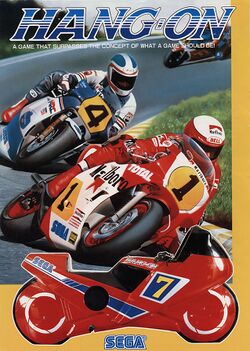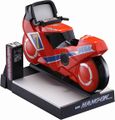BrownDerby (talk | contribs) m (series template) |
(reorganize page a bit) |
||
| (2 intermediate revisions by 2 users not shown) | |||
| Line 1: | Line 1: | ||
{{subpage|some of this info belongs on series page}} | {{subpage|some of this info belongs on series page}} | ||
{{Header Nav|game=Hang-On | {{Header Nav|game=Hang-On}} | ||
{{Game | {{Game | ||
|completion=0 | |||
|image=Hang-On arcade flyer.jpg | |||
|title=Hang-On | |title=Hang-On | ||
|developer=[[Sega-AM2]] | |developer=[[Sega-AM2]] | ||
|publisher=[[Sega]] | |publisher=[[Sega]] | ||
|year=1985 | |||
|systems={{syslist|cade|sg1000|sms|ss|msx|gba}} | |||
|designer=Yu Suzuki | |designer=Yu Suzuki | ||
|genre=[[Racing]] | |genre=[[Racing]] | ||
|modes=[[Single player]] | |modes=[[Single player]] | ||
|followed by=[[Super Hang-On]] | |followed by=[[Super Hang-On]] | ||
|series=Hang-On | |series=Hang-On | ||
}} | }} | ||
{{marquee|HangOn_marquee.png}} | {{marquee|HangOn_marquee.png}} | ||
{{nihongo|'''Hang-On'''|ハングオン}} is an [[arcade]] [[racing]] game released by [[Sega]] in [[1985]] and later ported to the [[Sega Master System]]. In the game, the player controls a motorcycle against time and other computer-controlled bikes. It was one of the first arcade games to use 16-bit graphics and uses the Super Scaler arcade system board, created with design input from Yu Suzuki, as technology to simulate 3D effects. The deluxe cabinet version also introduced a motion-controlled arcade cabinet, where the player's body movement on a large motorbike-shaped cabinet corresponds with the player character's movements on screen. | |||
The | Using a behind the motorcycle perspective, the player races a linear race track divided into several stages within a limited time. Players have to lean the motorcycle to turn, with tighter corners requiring a further lean. A throttle similar to a motorcycle has to be twisted to accelerate the bike. The game has one track, pieced together in segments. Reaching a checkpoint at the end of each segment extends the time limit, and remaining time is carried over into the next stage. Running off the track results in the motorcycle crashing and the rider is launched into the air. The game ends if the time runs out or all five stages are completed. | ||
Yu Suzuki began development of ''Hang-On'' after deciding to design a motorcycle racing game as a way to use a torsion bar in an arcade game. With market research suggesting GP 500 racing was popular, Suzuki took inspiration from world champion Freddie Spencer and his style of racing. The game's soundtrack was written by Hiroshi Kawaguchi, who used rock music that was uncommon in arcade games at the time. | |||
''Hang-On'' was very popular at launch and sold well for Sega, becoming the highest-grossing arcade video game of 1985 in the United States and then the highest-grossing arcade game of 1986 in both Japan and the United States. It received a positive critical reception for its realism, graphics, bike cabinet and physical controls, though there was some initial controversy in Japan over modesty concerns involving female players with the bike cabinet. The game started the trend of "taiken" motion simulator games in the late 1980s, which Sega followed with hits such as [[Space Harrier]] (1985), [[Out Run]] (1986) and [[After Burner]] (1987); this helped the arcade video game market recover during the late 1980s. Hang-On has been recognized as a well-remembered and influential arcade game. Several sequels were later made for arcades, as well as video game consoles. | |||
<gallery | <gallery> | ||
File:HangOn arcadephoto.jpg|Upright version of the arcade | File:HangOn arcadephoto2.jpg|Motorcycle sim arcade design. | ||
File:HangOn arcadephoto.jpg|Upright version of the arcade cabinet. | |||
</gallery> | |||
<gallery> | |||
File:HangOn smscover.jpg|Cartridge version cover art for the Sega Master System. | File:HangOn smscover.jpg|Cartridge version cover art for the Sega Master System. | ||
File:HangOn smscardcover.jpg|Card version cover art for the Sega Master System. | File:HangOn smscardcover.jpg|Card version cover art for the Sega Master System. | ||
File:HangOn-SafariHunt cover.jpg|Hang-On / Safari Hunt Combo Cartridge cover. | File:HangOn-SafariHunt cover.jpg|Hang-On / Safari Hunt Combo Cartridge cover. | ||
File:AstroWarrior-HangOn cover.jpg|Hang-On / Astro Warrior Combo Cartridge cover. | File:AstroWarrior-HangOn cover.jpg|Hang-On / Astro Warrior Combo Cartridge cover. | ||
</gallery> | </gallery> | ||
==Sequels and | ==Sequels and cameos== | ||
In [[1987]], it was followed by a sequel [[Super Hang-On]] for arcade, and later for a range of platforms including the [[Sega Genesis]], [[ZX Spectrum]], [[Commodore 64]], [[Amstrad CPC]], [[Commodore Amiga]] and [[Atari ST]]. A polygon based sequel, developed by [[Genki]], was released for the [[Sega Saturn]], named variously [[Hang-On GP '95]] (Japan), [[Hang-On GP]] (USA) and [[Hang-On GP '96]] (Europe). It also appeared for the [[Game Boy Advance]] as part of the compilation [[Sega Arcade Gallery]]. | In [[1987]], it was followed by a sequel [[Super Hang-On]] for arcade, and later for a range of platforms including the [[Sega Genesis]], [[ZX Spectrum]], [[Commodore 64]], [[Amstrad CPC]], [[Commodore Amiga]] and [[Atari ST]]. A polygon based sequel, developed by [[Genki]], was released for the [[Sega Saturn]], named variously [[Hang-On GP '95]] (Japan), [[Hang-On GP]] (USA) and [[Hang-On GP '96]] (Europe). It also appeared for the [[Game Boy Advance]] as part of the compilation [[Sega Arcade Gallery]]. | ||
| Line 53: | Line 53: | ||
[[Category:Sega]] | [[Category:Sega]] | ||
[[Category:Racing]] | [[Category:Racing]] | ||
[[Category:Single player]] | [[Category:Single player]] | ||
[[Category:MAME]] | [[Category:MAME]] | ||
Latest revision as of 01:33, 17 September 2022
This is the first game in the Hang-On series. For other games in the series see the Hang-On category.

| Hang-On | |
|---|---|
| Developer(s) | Sega-AM2 |
| Publisher(s) | Sega |
| Year released | 1985 |
| System(s) | Arcade, Sega SG-1000, Sega Master System, Sega Saturn, MSX, Game Boy Advance |
| Followed by | Super Hang-On |
| Series | Hang-On |
| Designer(s) | Yu Suzuki |
|---|---|
| Genre(s) | Racing |
| Modes | Single player |
Hang-On (ハングオン?) is an arcade racing game released by Sega in 1985 and later ported to the Sega Master System. In the game, the player controls a motorcycle against time and other computer-controlled bikes. It was one of the first arcade games to use 16-bit graphics and uses the Super Scaler arcade system board, created with design input from Yu Suzuki, as technology to simulate 3D effects. The deluxe cabinet version also introduced a motion-controlled arcade cabinet, where the player's body movement on a large motorbike-shaped cabinet corresponds with the player character's movements on screen.
Using a behind the motorcycle perspective, the player races a linear race track divided into several stages within a limited time. Players have to lean the motorcycle to turn, with tighter corners requiring a further lean. A throttle similar to a motorcycle has to be twisted to accelerate the bike. The game has one track, pieced together in segments. Reaching a checkpoint at the end of each segment extends the time limit, and remaining time is carried over into the next stage. Running off the track results in the motorcycle crashing and the rider is launched into the air. The game ends if the time runs out or all five stages are completed.
Yu Suzuki began development of Hang-On after deciding to design a motorcycle racing game as a way to use a torsion bar in an arcade game. With market research suggesting GP 500 racing was popular, Suzuki took inspiration from world champion Freddie Spencer and his style of racing. The game's soundtrack was written by Hiroshi Kawaguchi, who used rock music that was uncommon in arcade games at the time.
Hang-On was very popular at launch and sold well for Sega, becoming the highest-grossing arcade video game of 1985 in the United States and then the highest-grossing arcade game of 1986 in both Japan and the United States. It received a positive critical reception for its realism, graphics, bike cabinet and physical controls, though there was some initial controversy in Japan over modesty concerns involving female players with the bike cabinet. The game started the trend of "taiken" motion simulator games in the late 1980s, which Sega followed with hits such as Space Harrier (1985), Out Run (1986) and After Burner (1987); this helped the arcade video game market recover during the late 1980s. Hang-On has been recognized as a well-remembered and influential arcade game. Several sequels were later made for arcades, as well as video game consoles.
-
Motorcycle sim arcade design.
-
Upright version of the arcade cabinet.
-
Cartridge version cover art for the Sega Master System.
-
Card version cover art for the Sega Master System.
-
Hang-On / Safari Hunt Combo Cartridge cover.
-
Hang-On / Astro Warrior Combo Cartridge cover.
Sequels and cameos[edit]
In 1987, it was followed by a sequel Super Hang-On for arcade, and later for a range of platforms including the Sega Genesis, ZX Spectrum, Commodore 64, Amstrad CPC, Commodore Amiga and Atari ST. A polygon based sequel, developed by Genki, was released for the Sega Saturn, named variously Hang-On GP '95 (Japan), Hang-On GP (USA) and Hang-On GP '96 (Europe). It also appeared for the Game Boy Advance as part of the compilation Sega Arcade Gallery.
In Power Drift, the motorcycle is a hidden vehicle and can only be accessed by finishing first place for all five tracks on courses A, C, and E. It is only playable in the Extra Stage.
In Sonic Riders, there is an unlockable Gear called the "Hang-On", which plays the song from this game during use. Sonic Riders: Zero Gravity has this gear as an unlockable (in the form of the sit-down arcade cabinet), however, collecting 100 rings and pressing a button during a race changes the gear (and main music) to the sequel's sit-down arcade cabinet and Outride a Crisis from said game.
The Sega Dreamcast games Shenmue and Shenmue II both feature "Hang-On" as a mini-game, as well as the ability to win miniature toy versions of the bikes from gashapon machines.
In Daytona USA, if one enters "H.O" as his initials, a clip of the main theme from Hang-On will play.







